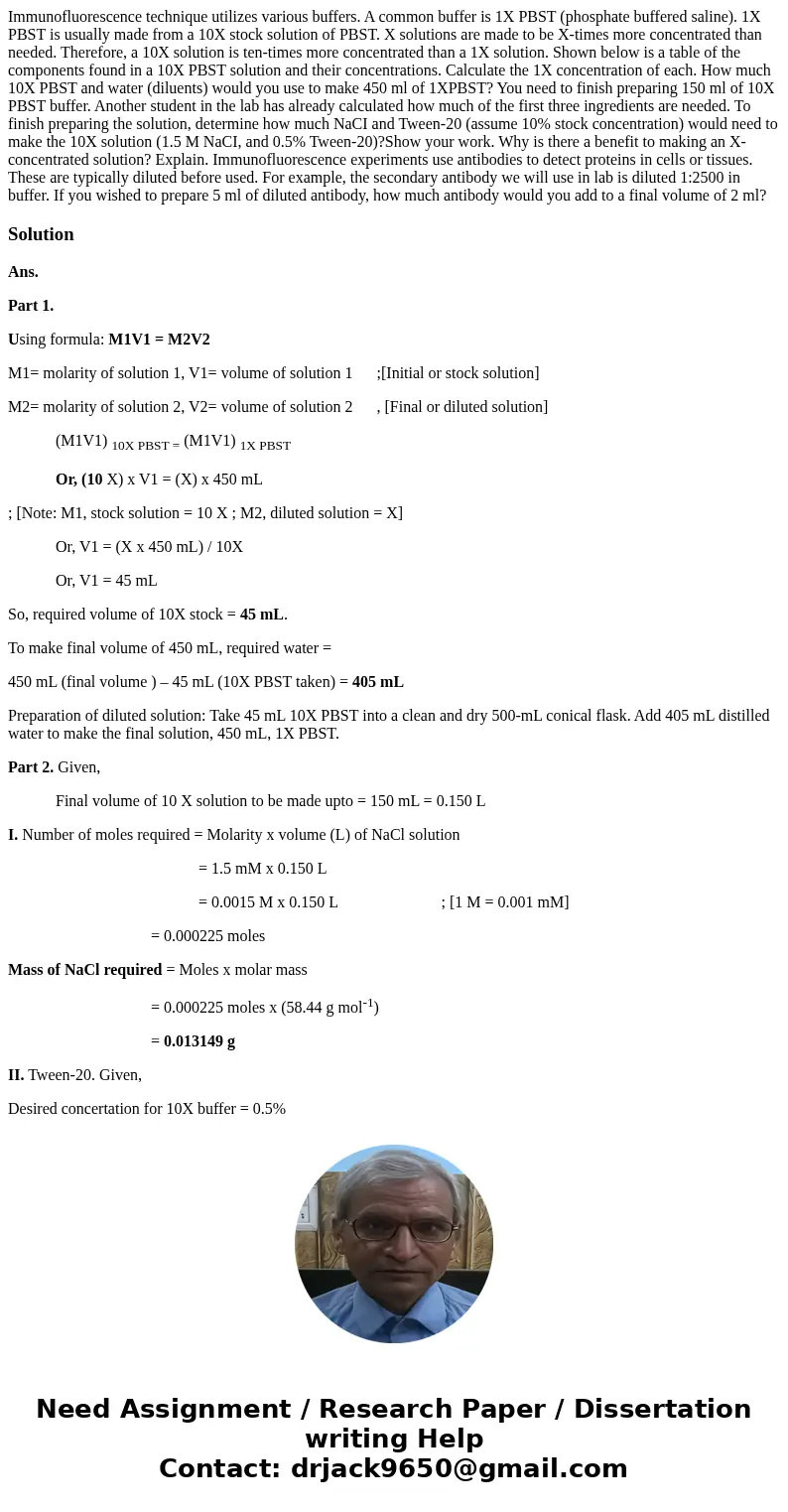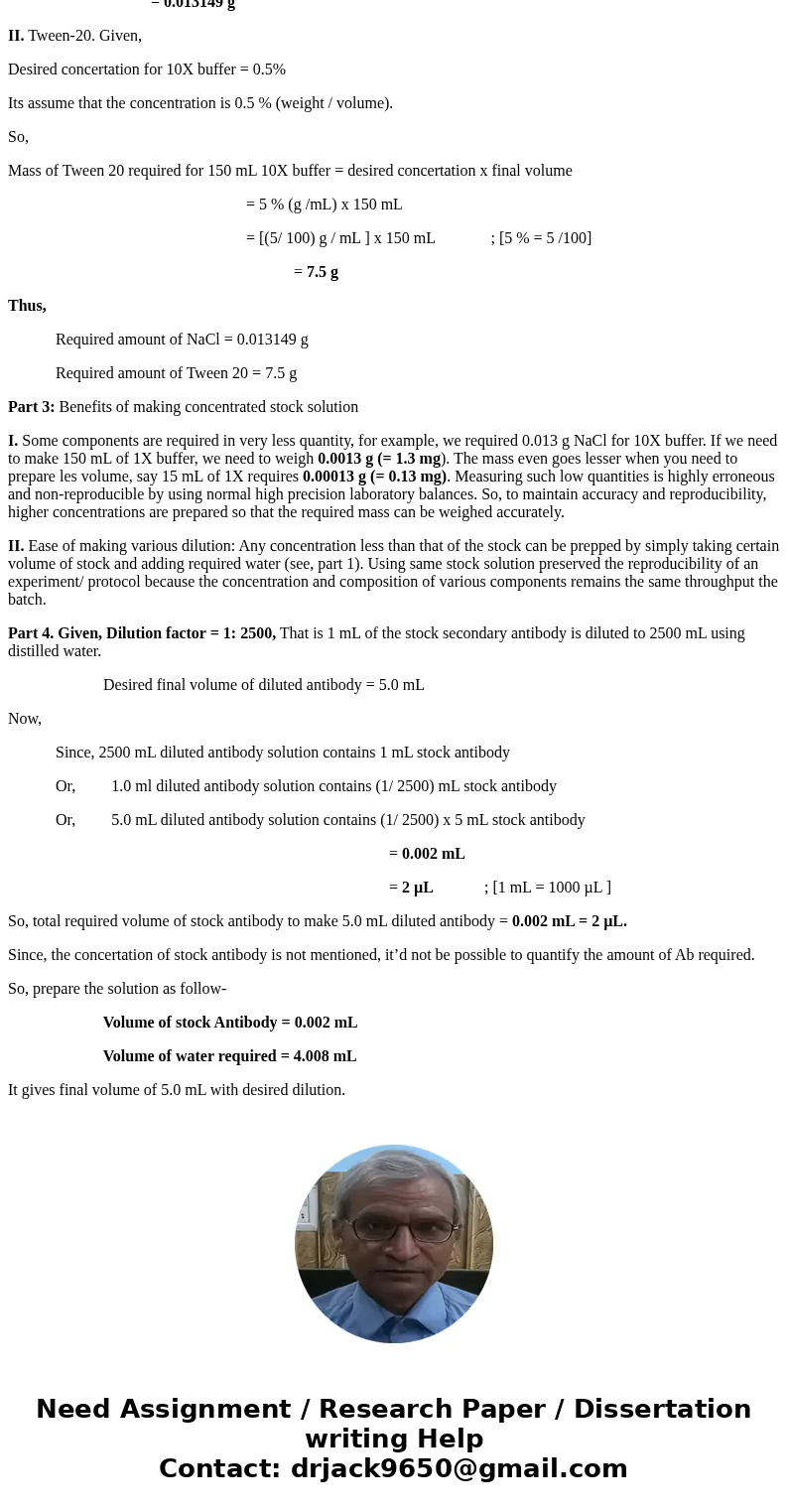Immunofluorescence technique utilizes various buffers A comm
Solution
Ans.
Part 1.
Using formula: M1V1 = M2V2
M1= molarity of solution 1, V1= volume of solution 1 ;[Initial or stock solution]
M2= molarity of solution 2, V2= volume of solution 2 , [Final or diluted solution]
(M1V1) 10X PBST = (M1V1) 1X PBST
Or, (10 X) x V1 = (X) x 450 mL
; [Note: M1, stock solution = 10 X ; M2, diluted solution = X]
Or, V1 = (X x 450 mL) / 10X
Or, V1 = 45 mL
So, required volume of 10X stock = 45 mL.
To make final volume of 450 mL, required water =
450 mL (final volume ) – 45 mL (10X PBST taken) = 405 mL
Preparation of diluted solution: Take 45 mL 10X PBST into a clean and dry 500-mL conical flask. Add 405 mL distilled water to make the final solution, 450 mL, 1X PBST.
Part 2. Given,
Final volume of 10 X solution to be made upto = 150 mL = 0.150 L
I. Number of moles required = Molarity x volume (L) of NaCl solution
= 1.5 mM x 0.150 L
= 0.0015 M x 0.150 L ; [1 M = 0.001 mM]
= 0.000225 moles
Mass of NaCl required = Moles x molar mass
= 0.000225 moles x (58.44 g mol-1)
= 0.013149 g
II. Tween-20. Given,
Desired concertation for 10X buffer = 0.5%
Its assume that the concentration is 0.5 % (weight / volume).
So,
Mass of Tween 20 required for 150 mL 10X buffer = desired concertation x final volume
= 5 % (g /mL) x 150 mL
= [(5/ 100) g / mL ] x 150 mL ; [5 % = 5 /100]
= 7.5 g
Thus,
Required amount of NaCl = 0.013149 g
Required amount of Tween 20 = 7.5 g
Part 3: Benefits of making concentrated stock solution
I. Some components are required in very less quantity, for example, we required 0.013 g NaCl for 10X buffer. If we need to make 150 mL of 1X buffer, we need to weigh 0.0013 g (= 1.3 mg). The mass even goes lesser when you need to prepare les volume, say 15 mL of 1X requires 0.00013 g (= 0.13 mg). Measuring such low quantities is highly erroneous and non-reproducible by using normal high precision laboratory balances. So, to maintain accuracy and reproducibility, higher concentrations are prepared so that the required mass can be weighed accurately.
II. Ease of making various dilution: Any concentration less than that of the stock can be prepped by simply taking certain volume of stock and adding required water (see, part 1). Using same stock solution preserved the reproducibility of an experiment/ protocol because the concentration and composition of various components remains the same throughput the batch.
Part 4. Given, Dilution factor = 1: 2500, That is 1 mL of the stock secondary antibody is diluted to 2500 mL using distilled water.
Desired final volume of diluted antibody = 5.0 mL
Now,
Since, 2500 mL diluted antibody solution contains 1 mL stock antibody
Or, 1.0 ml diluted antibody solution contains (1/ 2500) mL stock antibody
Or, 5.0 mL diluted antibody solution contains (1/ 2500) x 5 mL stock antibody
= 0.002 mL
= 2 µL ; [1 mL = 1000 µL ]
So, total required volume of stock antibody to make 5.0 mL diluted antibody = 0.002 mL = 2 µL.
Since, the concertation of stock antibody is not mentioned, it’d not be possible to quantify the amount of Ab required.
So, prepare the solution as follow-
Volume of stock Antibody = 0.002 mL
Volume of water required = 4.008 mL
It gives final volume of 5.0 mL with desired dilution.


 Homework Sourse
Homework Sourse